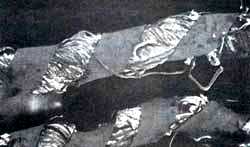Feat of filigree
 SCIENTISTS are often awestruck by the quality achieved by craftspersons hundreds of years ago which, they believe, would be hard to equal even using the tools of modern technology. For instance, experts have been intrigued by the rust-resistant alloy of the Iron Pillar at the Qutab Minar in Delhi, whose composition they have been unable to figure out.
SCIENTISTS are often awestruck by the quality achieved by craftspersons hundreds of years ago which, they believe, would be hard to equal even using the tools of modern technology. For instance, experts have been intrigued by the rust-resistant alloy of the Iron Pillar at the Qutab Minar in Delhi, whose composition they have been unable to figure out.
Now scientists have recorded yet another technological marvel from medieval India. Uma Shankar Lal and B V Kharbade of the Lucknow-based National Research Laboratory for Conservation of Cultural Property have found extremely thin gold and silver threads (jari) intricately interlaced in a 17th-century Mughal tent.
Under the fine scrutiny of an electron microscope, the jari revealed, to the scientists' surprise, an amazingly uniform blending of lacings of gold in silver. The thickness of the gold layer on the outer and the inner sides was between 2 and 3 micrometres (1:10,000 of a centimetre) and the middle silver core was 6 to 8 micrometres thick. Such well-defined layers in such thin wires is a technological feat that, the scientists say, even modern technology cannot achieve.
So regular was the pattern of layers that the scientists decided to accept the brocade as "textured to technology". They concluded that such uniformity was only possible through machines. Says Lal, "The baffling consistency in the making of the, threads is possible only with a machine."
The scientists believe that the jari was made using a mechanical factotum that could draw and flatten wires from a block of gold covered silver. This was essentially manually powered but had an efficient system of gears for imparting the requisite uniformity.
